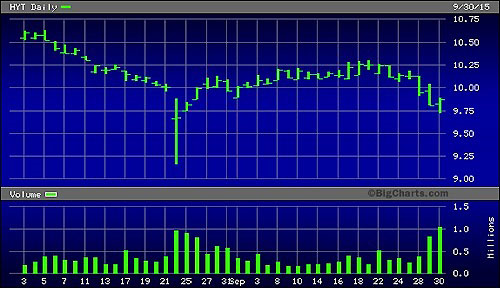By Pam Martens and Russ Martens: October 1, 2015
An uncanny number of people woke up this week with the same thought – it’s time to panic over the size, structure and illiquidity of the junk bond market. (Not to put too fine a point on it, but Wall Street On Parade made the warning in 2013 and again on August 18 of this year.)
On Tuesday morning, it was both Carl Icahn, the famous hostile takeover artist and hedge fund billionaire, along with the more staid academics at the International Monetary Fund (IMF), who issued junk bond warnings. (Junk bonds are corporate debt with ratings below investment grade, also known as “high yield” bonds.)
Icahn released a video (see clip below) assigning blame to companies like BlackRock which have bundled illiquid junk bonds into Exchange Traded Funds (ETFs), listed them on the New York Stock Exchange, and sat back and watched as millions of mom and pop investors were sold a bill of goods that these are liquid investments that can be exited at any time during the trading day. The danger, says Icahn, is that liquidity dries up when everyone heads for the exits at the same time. Icahn includes a graph in his video showing that the U.S. junk bond and leveraged loan market has grown from $1 trillion in 2007 to $2.2 trillion today.
Icahn pulled no punches in his assignment of blame, showing a cartoon of Fed Chair Janet Yellen and BlackRock CEO Larry Fink pushing a party bus filled with high yield revelers off a cliff, headed for impact against a “big black rock.” Icahn blames Yellen for keeping rates so excruciatingly low for so long that it created this imprudent search for yield without an appropriate assessment of risk.
The IMF also came out on Tuesday with a warning on junk bonds that carried a brain stumper title: “Market Liquidity Not in Decline But Prone to Evaporate.” Check out the plunge line on August 24 in the above chart for one of BlackRock’s junk bond ETFs to grasp the nuance of that title. August 24 is the day the Dow Jones precipitously dropped 1089 points shortly after the open, closing down 588 points on the day.
The IMF report notes the following:
“ ‘In recent years, factors such as investors’ higher risk appetite and low interest rates have been masking growing underlying fragilities in market liquidity,’ said Gaston Gelos, Chief of the Global Financial Stability Analysis Division at the IMF…
“If financial conditions worsen or investors become weary of a particular asset class or financial market, market liquidity can quickly evaporate. Furthermore, swings in market liquidity in one asset class seem to spill over to other asset classes more frequently, and high-yield and emerging market bonds show some signs of deterioration in market liquidity. As spillovers between asset classes increase, it becomes more likely for a liquidity shock in one market to spread to other markets, possibly leading to a shock to the global financial system, as was the case in 2008.”
Also on Tuesday, the Wall Street Journal added to the angst with this report:
“As of mid-September, nearly 15.7% of the roughly 1,720 bonds rated below investment grade traded at distressed levels, the biggest share since 2011, according to Standard & Poor’s Ratings Services. Such bonds were trading with yields at least 10 percentage points over comparable U.S. Treasurys. Yields on bonds rise when prices fall.
“Companies with distressed bonds may not be able to refinance or access other forms of capital, said Diane Vazza, an S&P managing director.”
Jesse Colombo, an economics contributor at Forbes, wrote yesterday: “I believe that junk bonds have experienced a speculative bubble in the past several years thanks to record low interest rates and quantitative easing, which pushed investors into these risky assets in order to earn higher returns. I also believe that a terrifying day of reckoning is ahead when the junk bond bubble ultimately pops.”
On top of mushrooming concerns over distressed U.S. corporate debt, there are growing concerns over foreign corporate debt owed to U.S. banks by struggling companies in emerging markets. Christine Lagarde, Managing Director of the IMF, delivered a speech yesterday in Washington, D.C. to the Council of the Americas which delineated the problem. Lagarde stated:
“…many emerging and developing economies responded to the global financial crisis with bold counter-cyclical fiscal and monetary actions. By using these policy buffers, they were able to lead the global economy in its time of need. And over the past five years, they have accounted for almost 80 percent of global growth.
“These policy actions generally went together with an increase in financial leverage in the private sector, and many countries have incurred more debt – a significant portion of which is in U.S dollars.
“So rising U.S. interest rates and a stronger dollar could reveal currency mismatches, leading to corporate defaults – and a vicious cycle between corporates, banks, and sovereigns.”
Lagarde is referring to the fact that the currencies of emerging market countries have declined dramatically against the U.S. dollar as the U.S. Fed has talked up the dollar with persistent predictions that it would be raising interest rates this year. That has caused the amount of the debt owed by emerging market companies to mushroom, since it takes more of their local currency to pay back the debt in U.S. dollars.
This raises another serious question. Would the benefit to U.S. mega banks from a Fed rate hike (allowing them to increase their loan rates) be more than offset by defaults of emerging market debt that resides quietly at present on their books?
Bloomberg Business has a story out this morning suggesting that there will not be a rational resolution to this problem. Japan’s $1.2 trillion government pension fund has announced it plans to invest in junk bonds.



